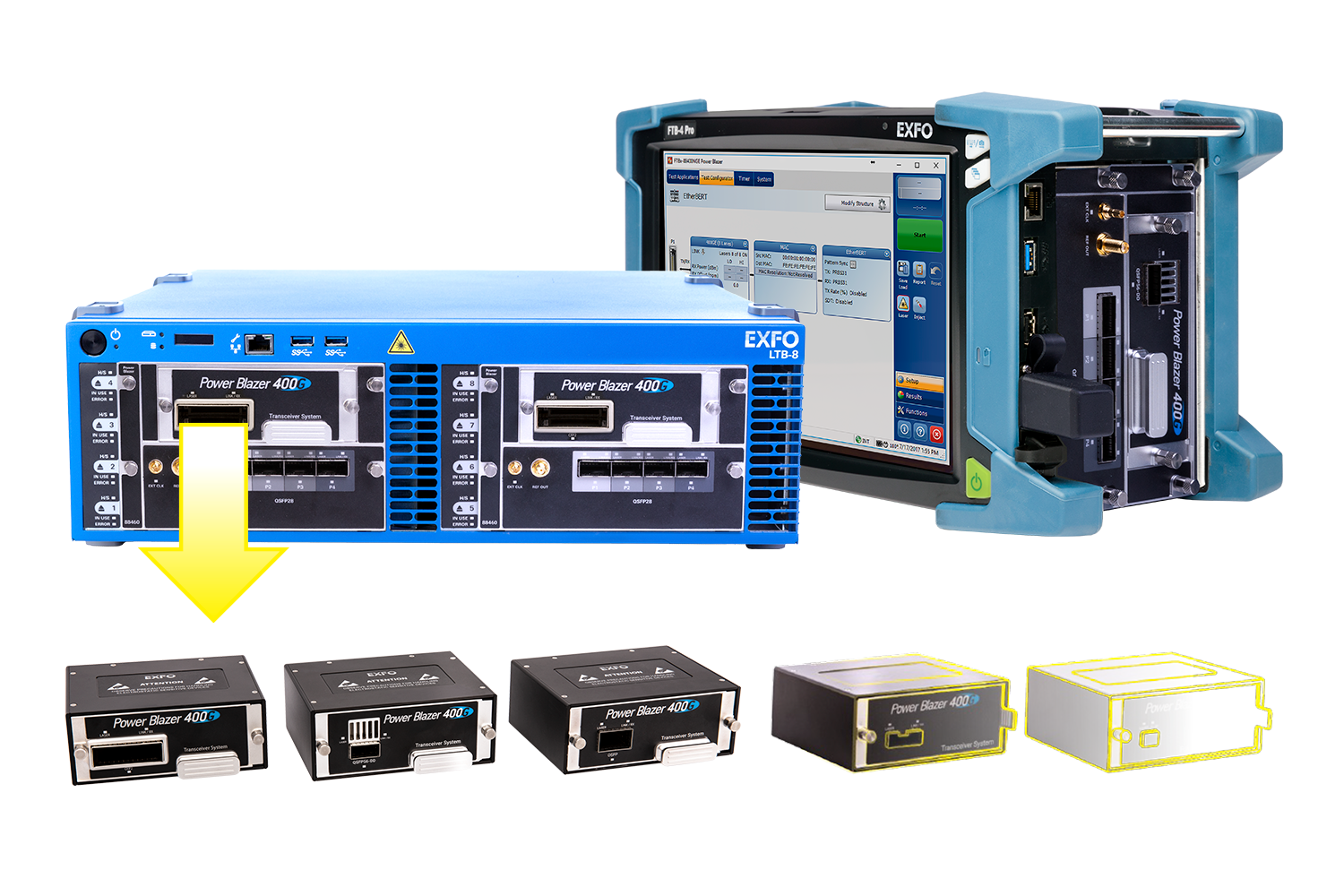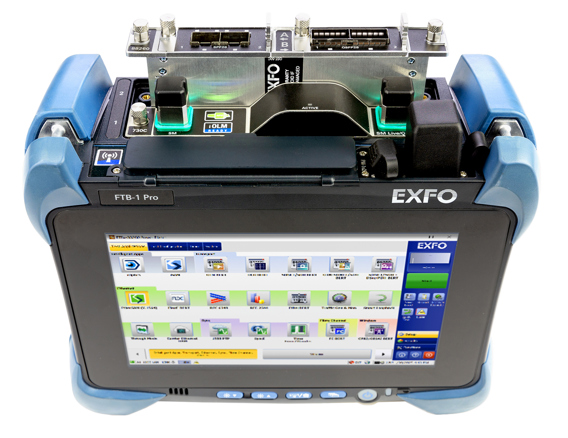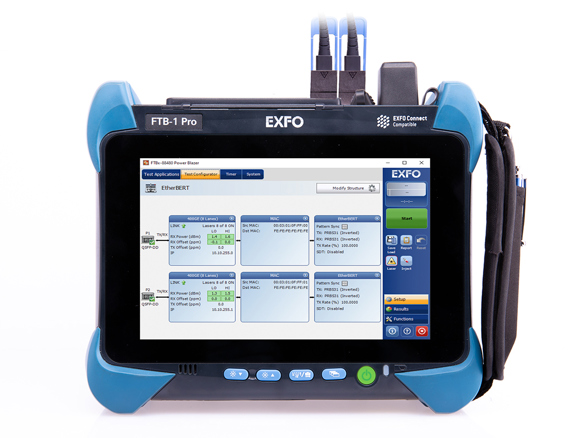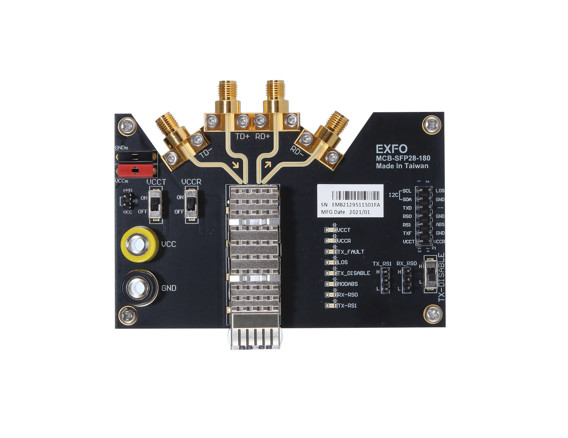Challenges
Emerging optical interfaces (e.g., ZR+, CFP2-DCO, QSFP112)
Description
400G Ethernet
400GE is today’s highest client rate in the Ethernet ecosystem according to the IEEE 802.3bs standard, offering improved capabilities for key aggregation and high‑bandwidth interconnect applications. These applications cover a wide range: cloud‑scale data centers, internet exchanges, colocation services, wireless infrastructure, service provider and operator networks and video distribution infrastructure.
EXFO’s 400G testing solutions are the most advanced in the industry, featuring a powerful, versatile and scalable test and measurement solution that incorporates rackmounts (LTB‑8/LTB-2) and portable (FTB-4 Pro/FTB-2 Pro) platforms with a wide variety of modules, providing unique flexibility.

The new 400G technology defines new physical layer specifications for 200 Gbit/s and 400 Gbit/s operation and introduces mandatory forward error correction (FEC) for correcting errors, targeting to compensate signal degradation and optimize link quality. Our high-speed testers feature a FEC statistics tool based on the Reed Salomon coding, also known as RS (544, 514), for which the codeword is structured with 544 symbols, where 514 symbols are dedicated for payload and 30 symbols for parity. This type of FEC can correct up to 15 symbols in error per codeword.
Related content:
- Reference Poster 400G
- Flyer: FTBx-88460 universal 400G solution for field and lab applications
- Flyer: Boost your 400G game with new FTBx-88480
PAM4: The key enabler of 400G technology
Latest 400G rate has been materialized in high-speed interfaces thanks to the implementation of 4-level pulse amplitude modulation (PAM4) that essentially doubles the density of data with respect to NRZ. PAM4 as a new coding technique, allows to drive 8 lanes of 50G or 4 lanes of 100G for different variants of CFP8, OSFP and QSFP-DD, replacing classical NRZ-based interfaces. In this framework, PAM4-based components deliver advantages but also introduce big challenges for testing, since analyzing the volume of a four-level system is more complex than NRZ. Also, PAM4’s amplitude is three times shorter than that of NRZ, the signal to noise ratio is lower and the spacing between encoding levels is tighter, as a result it is more susceptible to noise.
It is then highly complex to analyze and debug 400G PAM4-based interfaces since several parameters of the transceivers (e.g., optical power at Tx and Rx, the electrical power consumption, temperature, skew, etc.) must be tested before, during and after the installation in networks.
We provide a wide array of tools to analyze and debug PAM-4 based transceivers, such as pre-emphasis, equalization and PAM4 histogram (reference tool for representing the 4 electrical levels of the modulation, enabling the real time PAM4 analysis per lane).
Validation of transceivers in manufacturing
The 200G/400G new-generation transceivers are mass produced, at a pace of thousands per day, they must meet strict quality and reliability standards to function accurately in today’s demanding high-speed networks, including 5G. Manufacturers need simplified solutions capable of providing quick and accurate transceiver evaluation and validation at different stages of production to maintain that speed of production.
It is to address this need that we have designed our unique end-to-end solution for qualification of next-gen transceivers, including client-side testers and powered with a suite of analysis tools to quickly and easily validate the 200G/400G optical interfaces.

Boost your 400G game with the FTBx-88480
Whether it’s carrier labs testing the latest transceivers, or equipment manufacturers running tests on production floors, the need for 400G test solutions extends across lab and manufacturing applications. The FTBx-88480 enables busy lab environments to move smoothly and expertly between testing different rates (1G-400G), interfaces and transceivers.
Key benefits
EXFO’s high-speed solutions integrally complies with the 400G ecosystem by supporting the current 200G/400G optical interfaces for Ethernet testing, enabling the transport of flexible Ethernet MAC rates with FlexE technology and allowing the transport of larger client bandwidths based on existing OTN technology thanks to FlexO/OTUCn.
The Open Transceiver System (OTS) design future-proofs your testing equipment regarding next-gen transceivers. Simply insert to test specific transceiver types, including those used in 200G/400G systems (e.g., QSFP-DD and OSFP), eliminate the need to replace entire testing modules.
Our rackmount platform can simultaneously host optical testers (switches, power meters, light sources, optical spectrum analyzers, OTDRs) and T&D solutions, from 1G to 400G.
More people are now working from home. The Windows-based design brings high flexibility in EXFO’s 400G solution to perform tests and evaluations remotely using third-party remote desktop software.
The use of automation to manage complex tasks is particularly interesting given that service providers and network equipment manufacturers are being challenged to reduce OPEX. The remote control is also available for EXFO’s optical and T&D solution using the extended SCPI commands library or employing the API examples.

Applications
High-speed transceiver validation (optical and electrical test)
Bit error test
FlexE testing capabilities with low- and high-speed Ethernet clients
RFC 2544
Related products

BA-4000 - Electrical 800G Bit Error Rate Tester
Electrical BER tester supporting NRZ and PAM4 coding, with advanced FEC tools and with testing capabilities up to 800G.

CD-4000 - Optical and electrical CDR for 28 GBd/56 GBd
Efficient CDR solution for the production line.

EA-4000 - Optical and electrical sampling oscilloscope
The fastest sampling scope in the industry supporting 28G NRZ signals.

FTB-4-PRO - Test platform
The most flexible solution to test multiple technologies and high speed networks.

FTBx-88800 - 800G test solutions for the lab
Compact, powerful 800G traffic generation and monitoring. Industry’s first portable 800G test solution.

FTBx-88260 - 10M to 100G network tester
Customizable 10M -100G testing, including 100ZR coherent support, with multi-interface flexibility via EXFO’s Open Transceiver System (OTS)

FTBx-88480 Series - dual-port 1G-400G, 800G-ready testers
Compact, multiservice dual-port testing (1G-400G, 400ZR and 400ZR+). Includes EXFO’s modular Open Transceiver System (OTS). Software upgradeable to 800G.

FTBx-88460 - multiservice test solution for the lab
Advanced testing of the full suite of new 400G technologies in lab and R&D environments

FTBx-9160 - MEMS optical switch
Provides highly accurate and repeatable fiber-to-fiber switching

LTB-2 - rackmount modular mainframe
The LTB-2 is a powerful, scalable, two-slot modular rackmount platform designed for multiservice testing at central office environments and labs

LTB-8 - rackmount platform
Bring power to your lab with a powerful, scalable and hot-swappable eight-slot rackmount platform designed for advanced lab and manufacturing applications.

MA-4000 - All-in-one BER tester - MCB for 100G/400G
All-in-one solution to transceiver mass production with integration of bit error rate tester, module compliance board (MCB) and power supply

MCB - MCB to test next-gen transceivers
The module compliance board (MCB) enables the serial communication between the bit error rate (BER) tester and the optical transceiver.

MXS-9100 - MEMS matrix optical switch
Jointly developed with DiCon, this all-optical cross-connect technology is optimized for EXFO systems and software, providing fast protection switching at the fiber layer, automation of test sequences and instrument-grade performance

